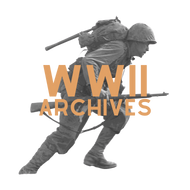William Gniecko
From WWII Archives
This article doesn't have enough information
The author(s) of this article created it without giving it any great amount of content, nor an abundant amount of sources to work with. |
This article is a source dump
Instead of using the sources dumped here to fully write the article and flesh it out, the original author(s) decided to instead just dump all the sources that they found on this subject here. |
William Gniecko was a 1st Lieutenant in the 29th Quartermaster Company of the 29th Infantry Division during WWII.
Childhood
Adulthood
March 1944 - Appointment to Graves Registration
In March 1944 Gniecko was appointed as the 29th Infantry Division's Graves Registration officer[1].
1 June 1944 - preparations for Operation Neptune
Gniecko and his four enlisted men were part of the 3604 Quartermaster Truck Company, and attached to the Division by V Corps[2].
6 June 1944 - D-Day
On 6 June 1944 Operation Neptune began. Gniecko, his group, and the other groups arrived on time 1000 yards (914.4m) from Omaha Beach, and were waiting to land at their scheduled times through the first or second wave. Due to insufficient amount of ferries to the shore, Gniecko, his group, and other groups, except for 2nd Lt Robert Rosenberg's section, they weren't able to get to the beach at the scheduled time. Throughout the day, they were left waiting off shore, and were exposed to strafing and bombing attacks by German planes. From their position, Gniecko and everyone else would have been able to watch the landings[3].
7 June 1944 - D+1
Between 1100 8 June to early 9 June 1944 - D+2 and D+3
Between 1100 of 8 June (the establishment of the company's bivouac) and early 9 June, Gniecko and his group of four enlisted men and a ¾ ton 4×4 Weapons Carrier were finally able to ferry to the beach, and able to join the company at its bivouac 1/2 miles (800m) south of Vierville-sur-Mer. His group was also joined by the other groups of the 3604 Quartermaster Truck Company,
The remaining groups of the that could immediately come in came in and joined the company at the bivouac south of Vierville-sur-Mer between its establishment and the early morning of D+3. These men and vehicles were from the 3604 Quartermaster Truck Company and attached to the Division by V Corps. They would have been sitting off shore waiting for One of the groups was under 1st Lieutenant William Gniecko which included four enlisted men and one ¾ ton 4×4 Weapons Carrier. Another was under 1st Lieutenant Lofton H. Alley, who was in charge of thirty-five vehicles and forty-six enlisted men. One of the other groups was under 2nd Lieutenant William E. Graf who was in charge of twenty vehicles and fifty-five enlisted men. Another was under 2nd Lieutenant John H. Rentschler who was in charge of twelve vehicles and twelve enlisted men. [4].
20 September 1990 - Letter to Robert M. Miller
On 20 September 1990, Gniecko wrote a letter to Robert M. Miller, who was in command of Fox Company of the 175th. In it he wrote an account of his experiences after starting the Graves Registration[5][6]:
I was appointed the division’s Graves Registration officer in March 1944. My first
direct order from Gen. Gerhardt when I went back to the command post on D+1
was to clean up the beach of bodies. I started the Graves Registration boys and all
idlers on the beach to help. The first cemetery was between the beach and the
cliffs. Despite shells, and even small arms fire, the job went apace. Using a bull-
dozer, we buried 456 men just off the beach.
This account is somewhat in contradiction to that of the After Action Report by Captain Frank B. Hines Jr. sometime after the battle, where Hines Jr said that his group had come on D+2[7], not D+1 as Gniecko claims here. 1990 was 56 years after D-Day, so it is possible that he had a slightly faulty memory and mistakenly said it was on D+1 instead of D+2, unlike Hines' report which was a month to a few months after the battle. It could be argued that Gniecko could have easily remembered the hundreds of dead bodies as he described and the smells and sight of it which might have made him remember it better, however on what day he came in could be argued to be an insignifiant detail in that experience. It could also be argued that Hines Jr could've forgotten as well. Due to the time span from the event between the sources it is to be considered that Hines Jr's account is more accurate since it is closer to D-Day.
Citations
- ↑ "William Gniecko". WWII Archives. 24 April 2023.
- ↑ "29th Quartermaster Company, 29th Infantry Division (United States)". WWII Archives. 24 April 2023.
- ↑ "29th Quartermaster Company, 29th Infantry Division (United States)". WWII Archives. 24 April 2023.
- ↑ "Frank B Hines Jr". WWII Archives. 21 April 2023.
- ↑ Balkoski. Omaha Beach : D-Day, June 6, 1944. p. 332.
- ↑ Balkoski. Omaha Beach : D-Day, June 6, 1944. p. 392.
- ↑ "Frank B Hines Jr". WWII Archives. 24 April 2023.
Bibliography
- https://worldwartwoveterans.org/wp-content/uploads/2020/06/1940-Maryland-National-Guard-part-2-SM.pdf
- Balkoski, Joseph (2004). Omaha Beach : D-Day, June 6, 1944. Mechanicsburg, PA: Stackpole Books. ISBN 0811700798.
- "Frank B Hines Jr". WWII Archives. 24 April 2023.
Contributors: Paul Sidle
